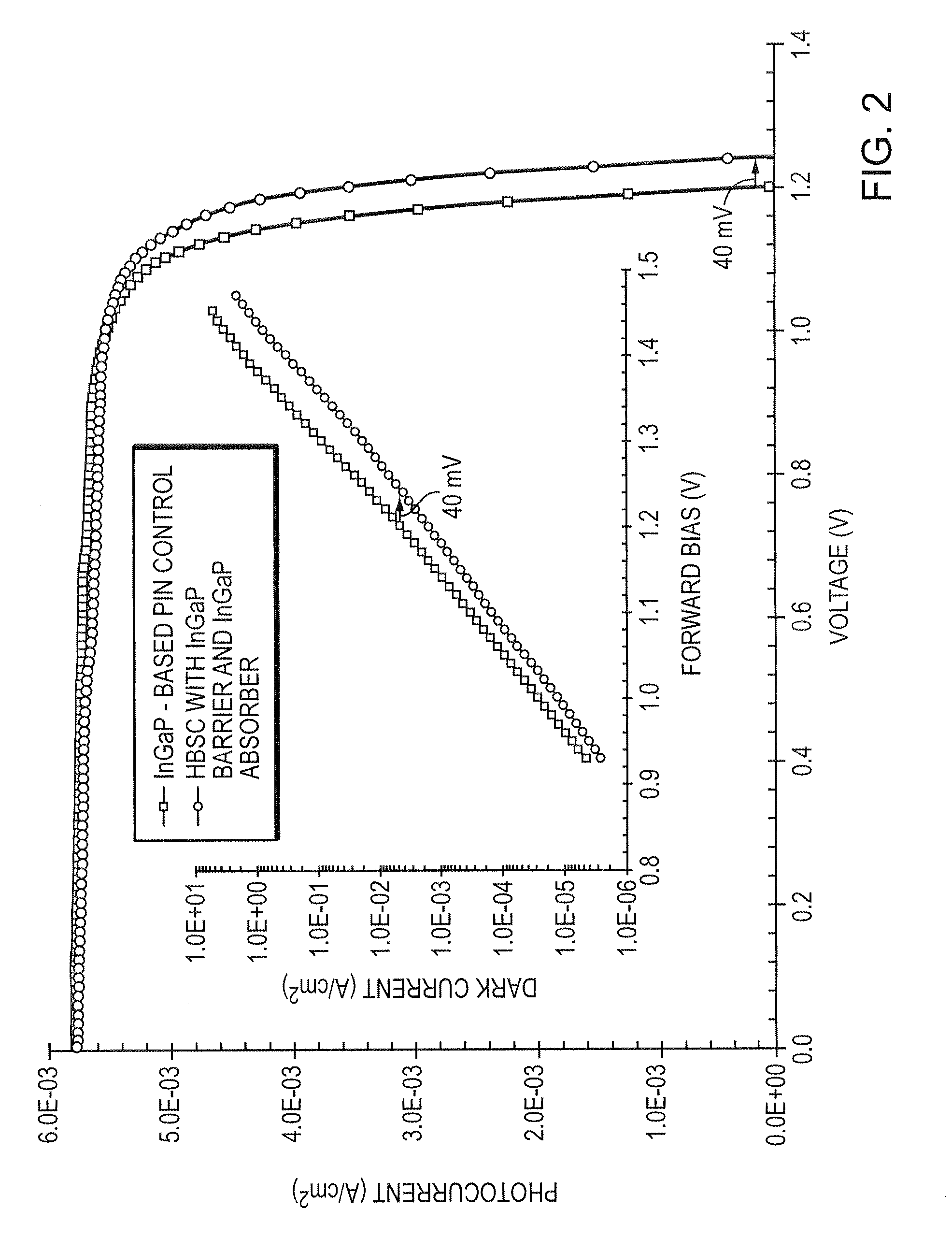Ingap heterojunction barrier solar cells
a solar cell and heterojunction technology, applied in the field of ingap heterojunction barrier solar cells, can solve the problems of diodes with higher dark currents than structures employing thin wells, low conversion efficiency, and low efficiency of incident solar power, so as to increase the short-circuit current, maximize the photocurrent, and enhance the photovoltaic conversion efficiency of hbsc
- Summary
- Abstract
- Description
- Claims
- Application Information
AI Technical Summary
Benefits of technology
Problems solved by technology
Method used
Image
Examples
example 1
InGaP Absorber Structure
[0036]HBSCs employing InGaP alloys for both the barrier and absorber layers werebuilt by inserting 30-50 nm wide, lattice-mismatched, gallium-rich InGaP layers into nearly lattice-matched, but slightly indium-rich InGaP-based PIN diode controls. The example HBSC structures were grown on MOCVD tools also employed for Kopin's high-volume heterojunction bipolar transistor (HBT) wafer production. The InGaP alloys are largely disordered, with an energy gap of 1.895 eV when perfectly matched to GaAs, as characterized by photoluminescence and X-ray diffraction measurements. The devices were fabricated with Kopin's standard Quick Lot process used to characterize HBT material. Further details on HBT production can be found in co-assigned U.S. Pat. No. 7,566,948, incorporated herein by reference in its entirety.
[0037]FIG. 2 is plot of measured photocurrent versus open-circuit voltage for an HBSC (circles) and a conventional InGaP-based PIN diode control (squares) illum...
example 2
GaAs Absorber Structure
[0040]In the second example, HBSCs were constructed by replacing the InGaP absorber layer with GaAs, which has a much lower energy-gap (Eg≈1.42 eV), and varying the thickness of the InGaP barrier layer using the techniques described above with respect to Example 1. [% Please provide more information on how you made these devices.]
[0041]FIG. 3 is a plot of the measured variation in dark diode current density at two bias levels of 0.8 V (squares) and 1.2 V (circles) of InGaP-based PIN diodes incorporating a wide GaAs well as a function of InGaP barrier layer thickness. The inset of FIG. 3 shows the full dark diode current versus voltage for different InGaP barrier thicknesses. Remarkably, the dark current does not begin to increase significantly until the InGaP barrier thickness drops below 50 nm, as shown in FIG. 3. Even a 30 nm thick InGaP barrier is sufficient to minimize dark current degradation at the higher bias relevant to solar cell operation.
[0042]In re...
PUM
 Login to View More
Login to View More Abstract
Description
Claims
Application Information
 Login to View More
Login to View More - R&D
- Intellectual Property
- Life Sciences
- Materials
- Tech Scout
- Unparalleled Data Quality
- Higher Quality Content
- 60% Fewer Hallucinations
Browse by: Latest US Patents, China's latest patents, Technical Efficacy Thesaurus, Application Domain, Technology Topic, Popular Technical Reports.
© 2025 PatSnap. All rights reserved.Legal|Privacy policy|Modern Slavery Act Transparency Statement|Sitemap|About US| Contact US: help@patsnap.com



